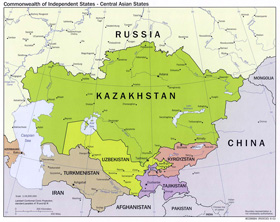The problem of sharing transboundary waters for China’s neighbouring countries comes to the fore. The Irtysh River, which connects three friendly countries – China, Kazakhstan and Russia – integrated by strategic cooperation, is the subject of negotiations at different levels now for the second decade. Although Russia and Kazakhstan have quickly come to a common understanding of how to jointly and efficiently manage the river, China is in a different position.
The problem of sharing transboundary waters for China’s neighbouring countries comes to the fore. The Irtysh River, which connects three friendly countries – China, Kazakhstan and Russia – integrated by strategic cooperation, is the subject of negotiations at different levels now for the second decade. Although Russia and Kazakhstan have quickly come to a common understanding of how to jointly and efficiently manage the river, China is in a different position.
China’s approach to the problem
The Irtysh River originates in China and called the Black Irtysh, it runs 672 km north-west through the border with Kazakhstan, and flows into the Ob River in Russia and ends its route, merging with the waters of the Arctic Ocean. Despite the pollution, the Irtysh water is a source of drinking water for 4 million people in Kazakhstan, and is used for industrial applications, agriculture, for hydroelectric power station located on the river, and for reservoirs. In Russia, the Irtysh River provides 90% of the water needs of the Omsk Region.
According to the Federal Agency for Water Resources of the Russian Federation, until recently, China took from the Black Irtysh 1-1.5 km3 of water a year, Kazakhstan – 3.8 km3, Russia – 0.43 km3. From 1997, China began increasing water intake from the watercourse of the Black Irtysh for irrigation of arid lands. The destabilizing factor was the construction of a 300-km irrigation canal Black Irtysh–Karamay, intended for irrigation of areas, expansion of areas under cotton and corn in the Xinjiang Uighur Autonomous Region (XUAR), and for the needs of the oil industry. With the commissioning of the channel into design capacity, China’s water intake from the river increased almost 5 times to 5 km3 per year.
In the future, during the development of its western provinces, China plans to build new canals, reservoirs, dams, hydroelectric power stations on the Irtysh River and on other smaller sources of transboundary rivers, which threatens an environmental catastrophe for Eastern and Central Kazakhstan. Already, experts are observing a shallowing of the 300-km Irtysh–Karaganda canal, and a sharp deterioration in the biological value of the water. Russia’s Omsk Region has also been classified as one of the regions facing water scarcity. On the Irtysh River near Omsk, there is massive formation of new islands and shoals, salinization of the floodplain, concentration of harmful substances in water, degradation of flora and fauna, and exposure of drinking and industrial water intakes.
The United Nations Convention on the Law of the Non-Navigational Uses of International Watercourses (1997) clearly states: “Watercourse States shall participate in the use, development and protection of an international watercourse in an equitable and reasonable manner. Such participation includes both the right to use the watercourse and the duty to cooperate in the protection and development ...” (Article 5).
“Watercourse States shall, in utilizing an international watercourse in their territories, take all appropriate measures to prevent the causing of significant harm to other watercourse States”. Where significant harm nevertheless is caused to another watercourse State, “...to discuss the question of compensation” (Article 7). But there is no China’s signature on any international legal instrument on transboundary waters.
The Kazakhstan has set before China the issue of rational shared management of transboundary rivers as early as 1996. For all the subsequent years, active diplomatic steps were taken to achieve a comprehensive discussion of the water problem. However, as noted by one of the investigators of the problem, A. Revsky, China prefers to avoid the discussion of specific issues, and refuses to participate in negotiations in a trilateral format, stating that “every case equires an individual approach”. China prefers negotiations on a bilateral basis.
Russian - Kazakh management program for the Irtysh River
In the early 1990s, Russia and Kazakhstan signed an intergovernmental Agreement on the joint use and protection of transboundary water bodies, and a Russian-Kazakh Commission was established for their joint use and protection. A new intergovernmental agreement was signed in 2010. Russian and Kazakh experts, together with their French colleagues, began developing an international project called “Transboundary management of the water resources of the Irtysh River Basin”. Moreover, two major problems were addressed: creation of an intergovernmental system for assessment, monitoring and control of the water resources of the basin; improvement of water supply and water quality. Digital maps of the vulnerability of the Irtysh River were developed, a monitoring system was optimized, the hydrological model of water balance of individual sections of the river and the projected scenarios of flowing resource were prepared taking into account China’s long-term plans of up to 2030. Participation of the third owner of the Irtysh drain in this work has become imperative.
On Astana’s initiative, an agreement on cooperation in the use and protection of transboundary rivers was signed with China in 2001 and a Kazakh-Chinese joint commission was established. In 2008, China and Russia signed an Intergovernmental Agreement on the rational use and protection of transboundary waters.
Attempts to formulate a common approach
Article 2 of the Agreement between the governments of Russia and Kazakhstan on the joint use and protection of transboundary water bodies proclaims the parties’ “cooperation” in the spirit of equality and partnership, in order to preserve, protect and restore resources... facilities”. The Agreement between the governments of Russia and China in the preamble proposes different principles: “a peaceful coexistence, mutual understanding, fair and rational use and protection of transboundary waters, taking into account economic, social and demographic factors...” The Agreement between the governments of Kazakhstan and China added to these principles, “the principle of mutual respect for independence, sovereignty and territorial integrity..., equality and mutual benefit”, as well as “mutual concessions”. Article 2 of the Agreement declares the need “to adhere to the principles of fairness and rationality, as well as work closely from the position of honesty, good neighbourliness and friendship”.
The Russian-Chinese and Kazakh-Chinese agreements set aside the issue of the parties’ liabilities. Articles 5, 6, 7 of the Russian-Kazakh document talk about coordination of any work on cross-border facility, while Article 8 declares “compensation of the injured party” of harm caused by “any action taken” by the other party. The preamble of the Russian-Chinese document refers to “conduct of friendly consultations and taking of coordinated actions”, refers to the need to inform the other party in the case of “water management activities that could lead to significant transboundary effects”. Article 3 of the Kazakh-Chinese agreement limits the efforts of the parties and talks about taking appropriate actions only “as a result of flood disasters and man-made accidents”. Article 4 is ambiguous: “None of the parties shall limit the other party to rationally use and protect water resources of transboundary rivers, taking into account mutual interests”.
As you can see, China has fundamentally different approaches as to the use of transboundary water bodies, and to the joint management of these facilities with another state. The bilateral agreements signed by China state only the possibility of declaring a “significant impact”, but do not contain legal tools for compensation of damage and elimination of the source of effect. According to experts, China’s reluctance is confirmed by the tactics of delaying negotiations on this issue, negotiations at the lowest level, and restriction of consultations with water agencies.
Russian expert, S. Luzyanin emphasizes China’s reluctance to discuss the problems of the Irtysh River in a trilateral format, or under SCO. At the same time, there is a problem with the joint management of Argun and Amur rivers, and Asian countries of the Mekong and Brahmaputra basins cannot solve the same water problems with China.
Conclusions
China’s use of transboundary waters reflects its hydro policy in relation to neighbouring countries, with which China signed treaties declaring the principle of good neighbourliness. Such a policy is contrary to the principles of friendship and good neighbourliness, cooperation within the framework of mutually beneficial and equal partnership, and inevitably leads to conflicts, ethnic and territorial problems. As a result, there is a real increase in anti-Chinese sentiment, which, in view of the above-said, can lead to intractable consequences.







